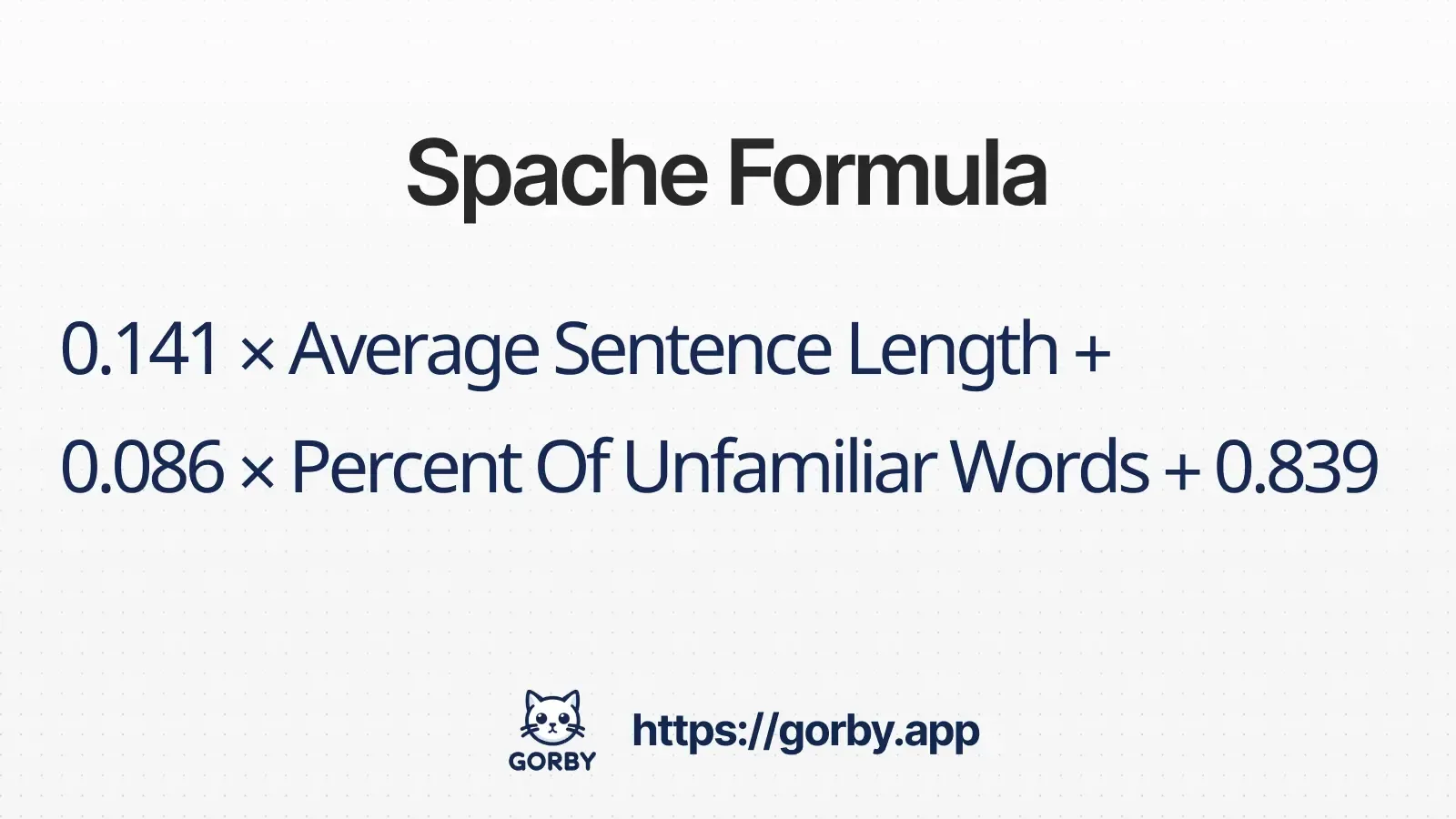Spache Readability Calculator
Instantly measure your text's readability using the Spache Readability Formula, specifically designed for primary-grade reading materials up to fourth grade. Unlike other readability formulas, Spache provides targeted assessment by analyzing sentence structures and word familiarity based on a carefully curated list of words familiar to young readers, making it particularly effective for evaluating early education materials.
Understanding the Spache Readability Formula

What is the Spache Readability Formula?
The Spache Readability Formula is a mathematical formula specifically designed to assess the reading difficulty of materials intended for primary-grade students (up to fourth grade). Unlike other readability formulas of its time that focused on adult materials, Spache developed this tool to address a critical gap in evaluating early reading materials.
What makes Spache unique is its focus on word familiarity rather than just word or sentence length. The formula evaluates text complexity by comparing words against a carefully curated list of words that young readers typically understand, combined with an analysis of sentence length. This approach makes it particularly valuable for educators, publishers, and writers creating content for early readers.
Origins and Development
Dr. George Spache introduced his formula in 1953 through his groundbreaking article "A New Readability Formula for Primary-Grade Reading Materials" in The Elementary School Journal. Existing readability metrics had a major flaw: the top three formulas (Flesch, Lorge, and Dale-Chall) couldn't assess texts intended for children reading below a fourth-grade level, prompting the development of a new method.
In his research, Spache analyzed 224 samples of 100 words each from 152 books commonly used in the first three grades. His work demonstrated that for primary-grade materials, sentence length was slightly more closely related to reading difficulty than vocabulary load, a finding that contrasted with studies of materials for older readers.
How Spache Stands Apart
The Spache formula distinguishes itself through several key features that make it especially suitable for primary-grade materials:
- Uses a specialized word list tailored for primary grades, based on words that fourth-grade students reliably understand
- Focuses specifically on the complexity levels relevant to early readers
- Accounts for the highly controlled vocabulary typically found in primary-grade materials
- Provides grade-level estimations specifically calibrated for early reading materials
Modern Applications
Today, the Spache Readability Formula continues to be a valuable tool in educational publishing and early literacy instruction. It's particularly useful for:
- Evaluating early reader books and educational materials
- Developing primary-grade textbooks and instructional content
- Assessing the appropriateness of reading materials for young students
- Supporting educators in selecting texts that match their students' reading abilities
While newer readability formulas have emerged, Spache remains particularly valuable for its specialized focus on primary-grade materials, where precise assessment of text difficulty is crucial for supporting early literacy development.
The Spache Readability Formula Explained
Understanding the Components
Based on Spache's original research, the formula combines two key measurements with carefully calibrated weights to determine reading difficulty for primary-grade materials:
Average Sentence Length
The first component (0.141 × average sentence length) measures syntactic complexity. Spache's research found that sentence length was particularly significant in primary-grade materials, where editors exercise careful control over sentence structure to support early readers.
Percentage of Unfamiliar Words
The second component (0.086 × percentage of unfamiliar words) evaluates vocabulary difficulty using Spache's Word List. Unfamiliar words are those not found in the Dale "Easy Word List" of 769 words, which represents vocabulary commonly known to young readers.
Adjustment Constant
The addition of 0.839 adjusts the raw score to align with primary grade levels. This constant was determined through analysis of 224 samples from 152 books commonly used in the first three grades, ensuring accurate grade-level correspondence.
Word Counting Guidelines
Spache established specific rules for counting words as familiar or unfamiliar, ensuring consistent application of the formula:
- Count all letters as familiar: A, B, C...
- Regular plurals and possessives of familiar words count as familiar
- Regular verb forms (-ing, -ed, -s) of familiar words are counted as familiar
- First names of people count as familiar words
Spache Readability Formula Grade Level Scale
The Spache Readability Formula provides grade-level estimates specifically calibrated for primary-grade materials, with scores corresponding to reading levels from early first grade through fourth grade.
| Score Range | Grade Level | Text Complexity |
|---|---|---|
| 1.2 - 1.5 | Early First Grade (Preprimer) | Very simple sentences, basic vocabulary |
| 1.6 - 1.8 | Mid First Grade (Primer) | Simple sentences, familiar words |
| 1.9 - 2.1 | Late First Grade | Slightly longer sentences, expanded vocabulary |
| 2.2 - 2.4 | Early Second Grade | More varied sentence structure |
| 2.5 - 2.7 | Mid Second Grade | Increased complexity in structure and vocabulary |
| 2.8 - 3.0 | Late Second Grade | More sophisticated sentence patterns |
| 3.1 - 3.3 | Early Third Grade | Complex sentences, broader vocabulary |
| 3.4 - 3.7 | Mid-Late Third Grade | Advanced primary-level content |
| 3.8 - 4.0 | Fourth Grade | Upper limit of formula's applicability |
Interpreting Spache Scores
The ideal Spache score depends on your target audience within the primary grades. When interpreting scores, consider these guidelines based on Spache's original research:
Early Readers (Grades 1-2)
Aim for scores between 1.2 and 2.7. Materials in this range help build foundational reading skills with controlled vocabulary and simple sentence structures.
Developing Readers (Grade 3)
Scores between 2.8 and 3.7 are appropriate, allowing for more complex sentence structures while maintaining vocabulary control.
Early Chapter Books
For transitional readers moving to chapter books, scores from 3.0 to 3.8 provide appropriate challenge while maintaining readability.
Educational Materials
For instructional texts, aim slightly below the student's grade level to ensure comprehension while learning new content.
📝 Pro Tip
When using the Spache Readability Formula, remember it was specifically designed for primary-grade materials. For texts aimed at readers above fourth grade, consider using other readability formulas like Dale-Chall. The goal is to match text difficulty to your readers' abilities while supporting their reading development.
Spache Readability Formula vs other readability metrics
While several readability formulas exist, the Spache Readability Formula offers unique advantages for evaluating primary-grade materials. Here's how it compares to other popular metrics:
Dale-Chall Readability Formula
While both formulas use word lists to evaluate text difficulty, Dale-Chall is designed for materials above fourth grade. Spache's specialized word list and formula weights are specifically calibrated for primary-grade materials, making it more accurate for early readers.
Flesch-Kincaid Grade Level
Flesch-Kincaid relies on syllable counts and sentence length. In contrast, Spache's use of a curated word list makes it more sensitive to vocabulary appropriateness for young readers, where word familiarity is often more important than word length.
Automated Readability Index
The ARI uses character and word counts for quick automated assessment. Spache's word list approach, though requiring more processing, provides more precise evaluation of vocabulary appropriateness for primary-grade readers.
When to Choose Spache
Choose the Spache Readability Formula when working with materials for readers up to fourth grade, especially for early literacy materials where precise vocabulary control is crucial. For higher grade levels, consider transitioning to Dale-Chall or other formulas designed for more advanced texts.
Tips to Improve Your Spache Score
Vocabulary Selection
- • Use words from the Spache word list when possible
- • Introduce new vocabulary gradually and with context
- • Repeat important words to reinforce learning
- • Define unfamiliar words within the text
Sentence Structure
- • Keep sentences short and direct
- • Use simple subject-verb-object patterns
- • Limit clauses and complex constructions
- • Maintain consistent tense within paragraphs
Content Organization
- • Group related ideas in short paragraphs
- • Use clear transitions between ideas
- • Present information in logical sequence
- • Include visual supports when possible
Review Process
- • Check Spache scores for each section
- • Read text aloud to assess flow
- • Test with target age group when possible
- • Review vocabulary distribution throughout text
Remember: The goal isn't always to achieve the lowest possible Spache score. Instead, aim for a score that matches your target audience's reading level while maintaining engagement and supporting vocabulary development. For primary-grade materials, controlled complexity can help build reading confidence and skills.
Ready to Analyze Your Text?
Explore a comprehensive suite of readability analysis tools to ensure your content matches your audience's needs.
Discover our text analyzer featuring multiple readability metrics, word counts, and writing suggestions. Get comprehensive insights into your text's complexity and readability.
Resources and References
Original Research Paper (1953)
Spache, G. (1953). "A New Readability Formula for Primary-Grade Reading Materials". The Elementary School Journal. 53 (7): 410–13 - The foundational paper that introduced the Spache Readability Formula and its innovative approach to evaluating primary-grade materials.
Spache Readability Formula
Wikipedia article providing a comprehensive overview of the formula's history, methodology, and applications in assessing primary-grade reading materials.
More Readability Tools
All Readability Metrics
Overview of all readability formulas and tools
Automated Readability Index (ARI)
Calculate grade level based on character count
Coleman-Liau Index
Analyze text complexity using characters per word
Dale-Chall Readability
Evaluate readability using word familiarity
Flesch Reading Ease
Measure text readability on a 100-point scale
Flesch-Kincaid Grade Level
Convert text complexity to U.S. grade levels
Gunning Fog Index
Measure text complexity using sentence length and word difficulty
SMOG Index
Assess readability based on polysyllabic words
Footer

Transform your writing from good to exceptional. Smart text analysis tools that help you craft content that resonates.
Core Features
Advanced Analysis
Company
© 2025 Gorby. All rights reserved.